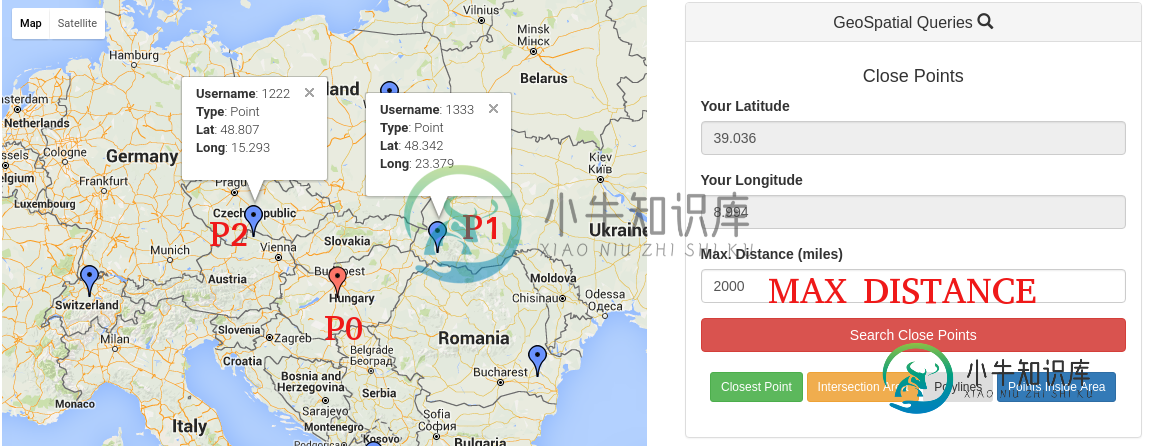在给定坐标和最大距离的情况下找到最接近某个点的点-使用带有MEAN Stack的Mongoose查询结果不确定
我有一个问题,即使在查看相关的Stack Overflow Q / A之后,也无法解决。
我正在使用Ahmed Haque方法重用Scotch的“创建MEAN Stack Google Map
App教程”
开发应用程序。
我试图实现使用的应用程序 谷歌地图API 绘制Points,LineStrings并且Polygons其坐标被包含在
以GeoJSON 存储在一个文件中 的MongoDB 实例。
我正在使用Mongoose数据构建架构并查询MongoDB数据库。
我想找到最接近的点
CP到一定点数P0给定P0's latitude and longitude,并给予最大半径
distance用来寻找感兴趣点。

给定图像,例如,如果我插入2000(公里),我的查询将找到距P0最大2000公里的所有点。在此示例中,它可能应该给我P1和P2。
当我的积分中只有积分时,我就能做到Mongoose Schema。
我Schema只有标记(点):
// Pulls Mongoose dependency for creating schemas
var mongoose = require('mongoose');
var Schema = mongoose.Schema;
// Creates a User Schema.
var MarkerSchema = new Schema({
username: {type: String, required: true},
location: {type: [Number], required: true}, // [Long, Lat]
created_at: {type: Date, default: Date.now},
updated_at: {type: Date, default: Date.now}
});
// Indexes this schema in 2dsphere format
MarkerSchema.index({location: '2dsphere'});
module.exports = mongoose.model('mean-markers', MarkerSchema);
这是我的Old Query for only Markers:
var User = require('./model.js');
app.post('/query/', function(req, res) {
// Grab all of the query parameters from the body.
var lat = req.body.latitude;
var long = req.body.longitude;
var distance = req.body.distance;
var reqVerified = req.body.reqVerified;
// Opens a generic Mongoose Query
var query = User.find({});
// ...include filter by Max Distance (converting miles to meters)
if (distance) {
// Using MongoDB's geospatial querying features
query = query.where('location').near({
center: {
type: 'Point',
coordinates: [long, lat]
},
// Converting meters to miles
maxDistance: distance * 1609.34,
spherical: true
});
}
});
它运行得非常好,而且我可以得出一些要点。
然后,我更改了自己的Schema动态性和支持性Polylines and Polygons。
我可以使用以下命令插入和绘制新的点,折线和多边形Schema:
var mongoose = require('mongoose');
var GeoJSON = require('geojson');
var Schema = mongoose.Schema;
// Creates a Location Schema.
var LocationSchema = new Schema({
name: {type: String, required: true},
location: {
type: {type : String, required: true},
coordinates : [Schema.Types.Mixed]
},
created_at: {type: Date, default: Date.now},
updated_at: {type: Date, default: Date.now}
});
LocationSchema.index({location: '2dsphere'});
module.exports = mongoose.model('mean-locations', LocationSchema);
这是我的Mongoose Query:
var GeoObjects = require('./model.js');
app.post('/query/', function(req, res) {
// Grab all of the query parameters from the body.
var lat = req.body.latitude;
var long = req.body.longitude;
var distance = req.body.distance;
var query;
if (distance) {
query = GeoObjects.find({'location.type':'Point'})
.where('location.coordinates').near({
center: {
type: 'Point',
coordinates: [lat, long]
},
// Converting meters to miles
maxDistance: distance * 1609.34,
spherical: true
});
}
// Execute Query and Return the Query Results
query.exec(function(err, users) {
if (err)
res.send(err);
console.log(users);
// If no errors, respond with a JSON of all users that meet the criteria
res.json(users);
});
});
console.log(users); 给我 undefined.
在我的 queryCtrl.js中 记录查询结果会给我以下错误消息:
name: "MongoError", message: "error processing query: ns=MeanMapApp.mean- locatio…ed error: unable to find index for $geoNear query", waitedMS: 0, ok: 0, errmsg: "error processing query: ns=MeanMapApp.mean-locatio…ed error: unable to find index for $geoNear query"
相同,但有一点变化:
app.post('/query/', function(req, res) {
// Grab all of the query parameters from the body.
var lat = req.body.latitude;
var long = req.body.longitude;
var distance = req.body.distance;
console.log(lat,long,distance);
var points = GeoObjects.find({'location.type':'Point'});
var loc = parseFloat(points.location.coordinates);
console.log(JSON.stringify(loc));
if (distance) {
var query = points.near(loc, {
center: {
type: 'Point',
coordinates: [parseFloat(lat), parseFloat(long)]
},
// Converting meters to miles
maxDistance: distance * 1609.34,
spherical: true
});
}
});
这是标记的示例:
{
"name": "user01",
"location": {
"type":"Point",
"coordinates": [102.0, 0.0]
}
}
$ near运算符如何与distance和maxDistance一起工作:
摘自Ahmed
Haque的Scotch用Google地图制作MEAN应用(第二部分)
MongoDB搜索参数$
near及其相关属性maxDistance和球形,用于指定我们要覆盖的范围。我们将查询正文的距离乘以1609.34,因为我们要获取用户的输入(以英里为单位)并将其转换为MongoDB期望的单位(以米为单位)。
- 我为什么要得到
undefined? - 此问题是否可能是由我的架构引起的?
- 我怎样才能解决这个问题?
如果您想得到一些澄清,请在下面发表评论。
提前致谢。
问题答案:
我终于设法解决了这个问题。
本质上,此问题是由模式引起的,因为2dIndex它被指向错误的字段(type and coordinates)。
我使用以下 模式 解决了:
var mongoose = require('mongoose');
var GeoJSON = require('geojson');
var Schema = mongoose.Schema;
var geoObjects = new Schema({
name : {type: String},
type: {
type: String,
enum: [
"Point",
"LineString",
"Polygon"
]
},
coordinates: [Number],
created_at: {type: Date, default: Date.now},
updated_at: {type: Date, default: Date.now}
});
// Sets the created_at parameter equal to the current time
geoObjects.pre('save', function(next){
now = new Date();
this.updated_at = now;
if(!this.created_at) {
this.created_at = now
}
next();
});
geoObjects.index({coordinates: '2dsphere'});
module.exports = mongoose.model('geoObjects', geoObjects);
和以下 查询 :
app.post('/query/', function(req, res) {
// Grab all of the query parameters from the body.
var lat = req.body.latitude;
var long = req.body.longitude;
var distance = req.body.distance;
var query = GeoObjects.find({'type':'Point'});
// ...include filter by Max Distance
if (distance) {
// Using MongoDB's geospatial querying features.
query = query.where('coordinates').near({
center: {
type: 'Point',
coordinates: [lat, long]
},
// Converting meters to miles
maxDistance: distance * 1609.34,
spherical: true
});
}
// Execute Query and Return the Query Results
query.exec(function(err, geoObjects) {
if (err)
res.send(err);
// If no errors, respond with a JSON
res.json(geoObjects);
});
});
希望对您有所帮助!
编辑
我提出的模式会给LineStringsand 带来一些问题Polygons。
这是允许使用的正确架构 geoQueries
linestring-model.js:
var mongoose = require('mongoose');
var Schema = mongoose.Schema;
// Creates a LineString Schema.
var linestrings = new Schema({
name: {type: String, required : true},
geo : {
type : {type: String,
default: "LineString"},
coordinates : Array
},
created_at: {type: Date, default: Date.now},
updated_at: {type: Date, default: Date.now}
});
// Sets the created_at parameter equal to the current time
linestrings.pre('save', function(next){
now = new Date();
this.updated_at = now;
if(!this.created_at) {
this.created_at = now
}
next();
});
linestrings.index({geo : '2dsphere'});
module.exports = mongoose.model('linestrings', linestrings);
多边形模型
var mongoose = require('mongoose');
var Schema = mongoose.Schema;
// Creates a Polygon Schema.
var polygons = new Schema({
name: {type: String, required : true},
geo : {
type : {type: String,
default: "Polygon"},
coordinates : Array
},
created_at: {type: Date, default: Date.now},
updated_at: {type: Date, default: Date.now}
});
// Sets the created_at parameter equal to the current time
polygons.pre('save', function(next){
now = new Date();
this.updated_at = now;
if(!this.created_at) {
this.created_at = now
}
next();
});
polygons.index({geo : '2dsphere'});
module.exports = mongoose.model('polygons', polygons);
LineString插入 :
{
"name" : "myLinestring",
"geo" : {
"type" : "LineString",
"coordinates" : [
[
17.811,
12.634
],
[
12.039,
18.962
],
[
15.039,
18.962
],
[
29.039,
18.962
]
]
}
}
多边形插入:
{
"name" : "Poly",
"geo" : {
"type" : "Polygon",
"coordinates" : [
[
[25.774, -80.190], [18.466, -66.118],
[32.321, -64.757], [25.774, -80.190]
]
]
}
}
-
给定一定数量的节点,是否有公式计算AVL树的最大和最小高度? 例如: 教科书中的问题: 一棵包含3个节点、5个节点和7个节点的AVL树的最大/最小高度是多少<教科书式答案: 3个节点的AVL树的最大/最小高度为2/2,5个节点为3/3,7个节点为4/3 我不知道他们是否通过一些神奇的公式计算出来,或者他们是否画出了每个给定高度的AVL树并以这种方式确定。
-
我有一段代码,它显示了随机矩阵中的最小值和最大值,而不使用min/max命令: 如何找到最小和最大坐标/位置?我只需要使用for或loop函数,我使用的是matlab版本2018a
-
我正在学习CLR中的一节,它描述了使用分而治之的方法,使用两点之间的欧几里德距离来找到最近的点对。 有一个问题,要求找到最近的点对之间的manhatten距离,使用类似的方法。但是,我不能把握两者之间的区别。以下是我能想到的: 3)递归到我们的点子集<=3为止(在这种情况下使用蛮力) 4)最小距离可以是从任何一个递归调用返回的距离--称它为D。 5)找到线“L”周围2D宽度内所有点,然后对于每个这
-
我想查询表A中每个点(id)到表B中每个多边形(id)的距离。对于距离计算,我使用ST_距离。但是,ST_Distance(显然)返回到每个多边形的距离。但我只需要每个点的“最接近”结果。到目前为止,我尝试了下面的查询,它返回了正确的结果,但是(当然)只返回了一个点。 结果应该是这样的: 你有什么提示吗?非常感谢你。 更新1 运行上述查询(3h 24m)后,返回的结果为空。然而,应该有一个结果。括
-
问题内容: 有一条折线,其中折线的顶点列表为[[x1,y1),(x2,y2),(x3,y3),…]和一个点(x,y)。在Shapely中,返回两个几何之间的最短距离。 但是我还需要找到最接近点(x,y)的线上的点的坐标。在上面的示例中,这是距离1.4142135623730951单位的对象上的点的坐标。计算距离时,该方法应具有坐标。有什么方法可以从此方法返回它吗? 问题答案: 您正在描述的GIS术
-
问题内容: 我有两个2d numpy数组:x_array包含x方向上的位置信息,y_array包含y方向上的位置。 然后,我有一长串x,y点。 对于列表中的每个点,我需要找到最接近该点的位置(在数组中指定)的数组索引。 我已经根据这个问题天真的产生了一些有效的代码: 在numpy数组中找到最接近的值 即 我正在大型数据集上执行此操作,并且真的想加快速度。谁能优化这个? 谢谢。 更新:根据@silv

